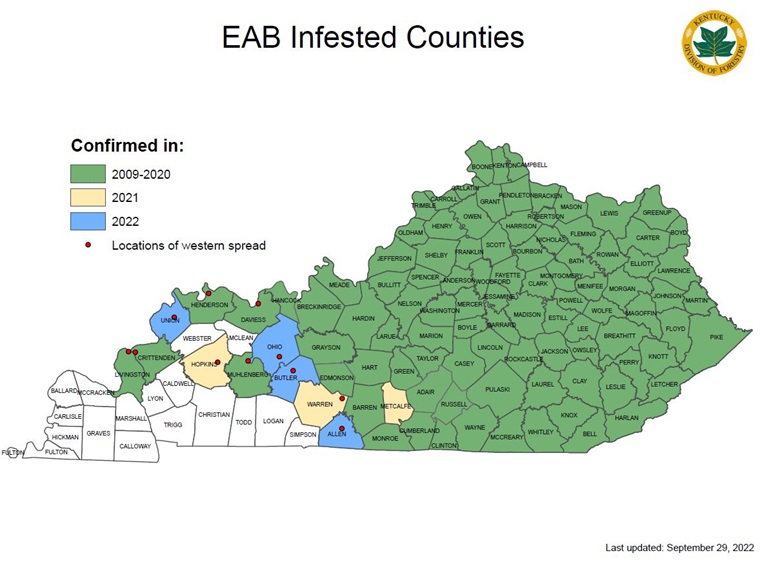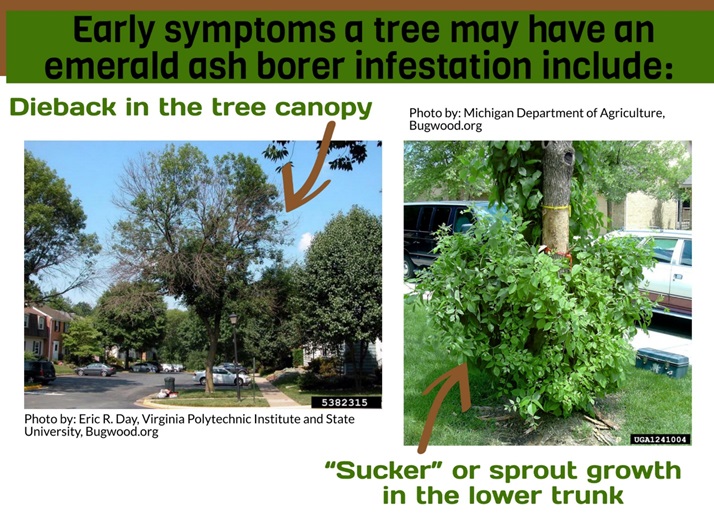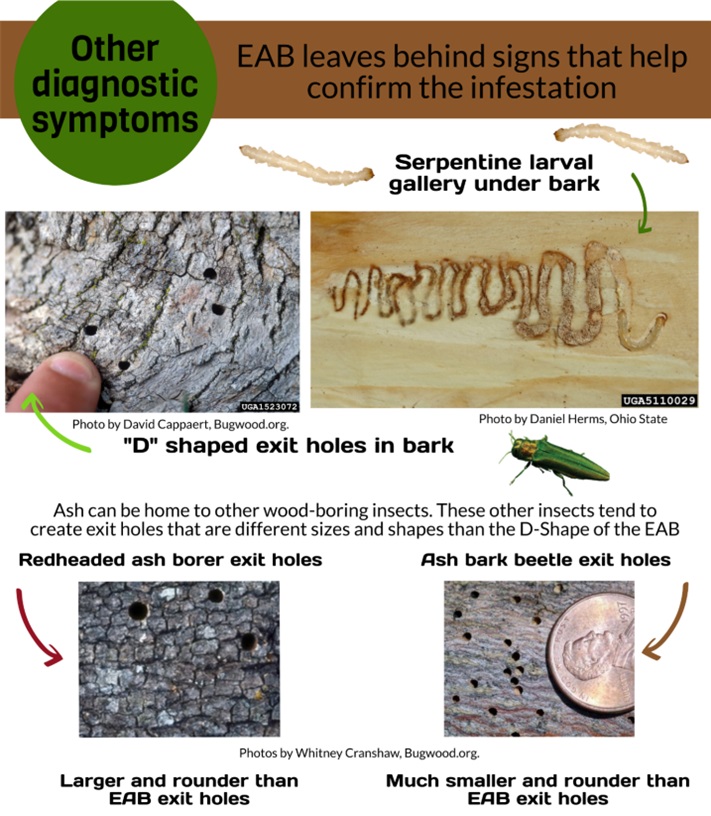Emerald Ash Borer (EAB) FAQs for Kentuckians
ENTFACT-453: Emerald Ash Borer (EAB) FAQs for Kentuckians | Download PDF
Jonathan Larson, Extension Entomologist and Ellen Crocker Forest Health Extension
Fast Facts
- Emerald ash borer (EAB) is an invasive beetle that infests and kills American ash species in the genus Fraxinus.
- As of the end of 2022, EAB has been found in 103 of the 120 counties in Kentucky. The newest finds were in Union, Ohio, Butler, and Allen counties (2022) and Hopkins, Warren, and Metcalfe counties (2021).
- EAB larvae live underneath the bark of infested trees, creating serpentine galleries in which they feed and grow, destroying the nutrient and water-conducting tissues.
- Over the course of several years, infested trees become unable to transfer food and water from the root zone and die.
- Healthy or newly infested ash trees can be treated with systemic insecticides to protect them from EAB.
Figure 1: As adults, emerald ash borers are small (1/2 long and about 1/8 inch wide), metallic green beetles. (Photo: Jim Kalisch, University of Nebraska-Lincoln)
Figure 2: Map of emerald ash borer in Kentucky, 2022 (Photo: Abe Nielsen, Kentucky Division of Forestry)
Potential Hosts
Emerald ash borer specializes on trees in the genus Fraxinus. In Kentucky, green, white, and blue ash are all attacked by EAB. White and green ash are readily killed, but blue ash is more resistant (it is thought to be less attractive to the female beetles laying eggs and better able to defend itself from larval development). EAB has also been found in white fringetree in natural and landscape settings and has been reared on devilwood in a laboratory setting. But the “true” ashes (white, green, and blue in KY) are the primary species of concern. Fortunately, EAB is unlikely to switch to different groups of trees and is no concern for other important tree species in the state (e.g., maple, oak). In addition, mountain ash trees (Sorbus americana) will not be infested as they are not true ash species and are instead more closely related to roses.
Symptoms
As the beetles develop, there will be multiple symptoms that may indicate a tree is infested with EAB. The first obvious signs will be branch dieback in the upper 1/3rd of the canopy. EAB tends to infest the upper portions of the plant first and moves downward over successive generations. Some may also notice an increase in woodpecker feeding activity on the tree. Infested trees also will produce suckers on the lower trunk. EAB adults produce a characteristic “D” shaped exit hole as they leave the host tree. As the infestation progresses, these “D” shaped holes may become more obvious at eye level on the trunk and large branches. The “D” shape is not always obvious and could also look like an irregular circle. As the trees moves towards death, vertical splits in the bark may also become obvious.
White and green ash trees can usually survive an infestation for 7-10 years before succumbing. However, trees can be killed faster (1-2 years) if beetle populations are high or if trees are already declining due to other issues. Blue ash, while damaged by EAB, can live much longer despite infestation.
Figure 3: Early symptoms of an EAB problem include branch dieback in the upper portions of the tree (left image) and “sucker” or sprout growth in the lower trunk (right). (Photos: Eric R. Day, Virginia Polytechnic Institute and State University and Michigan Department of Agriculture, Bugwood.org)
Figure 4: Individual EAB create serpentine larval galleries under the bark, that progress in size as the larvae grows. When adults emerge from trees, they create diagnostic “D” shaped exit holes in the bark of the host tree. Other ash borers create round or oval holes instead.
EAB Description
Immature EAB, or larvae, tunnel just under the bark of trees and are the damaging stage. They have a flattened appearance and are creamy white with brown heads. The larvae are legless and composed of 10 bell-shaped segments along the length of their body. These larvae belong to a group of beetle larvae referred to as flatheaded borers, however there are many different species of flatheaded borers that impact different tree species (such as the flatheaded apple tree borer on apple trees).
Figure 5: EAB larvae may not be visible, but they are damaging trees by extensively tunneling and cutting off the flow of water and nutrients. (Photo: Pennsylvania Department of Conservation and Natural Resources - Forestry, Bugwood.org)
EAB larvae feed in the cambium layer, beneath the bark of host trees and create winding, serpentine tunnels as they develop. They do not bore deeply into the tree while feeding, though they will penetrate farther into the tree to pupate. An individual tree can be home to many, many larvae over successive generations and as their feeding damage accumulates the tree will struggle to move nutrients and water throughout the plant and will die.
Figure 6: Emerald ash borer larvae do not bore their way into the heartwood of the tree but feed in the layers just below the bark. Their damage deprives the tree of nutrients and water, resulting in death. (Photo: Joseph O'Brien, USDA Forest Service, Bugwood.org)
Adult EAB are distinctive, dark, metallic green beetles that are about 1/2 long and about 1/8 inch wide. They emerge for a relatively brief window of time in early summer to mate and lay eggs. During this time, they also feed on the leaves of ash trees, although this causes minimal damage.
Life Cycle in Kentucky
In this region, EAB usually has a one-year life cycle.
Figure 7: EAB in Kentucky generally will have a one-year life cycle, with larvae feeding through the summer before overwintering. They will pupate in the spring with adults appearing by early summer to lay eggs for the next generation.
Management Options
Management considerations for EAB vary based on whether trees occur in woodland or landscape settings.
Key considerations in landscape settings include:
Insecticide treatment: Treatment with a systemic insecticide can provide healthy ash trees with protection from EAB. There are many different insecticide treatment options (different chemical formulations, brands names and application techniques) as well as different options for homeowner application versus professional application. However, treatment costs should be considered as they will need to be repeated regularly for the foreseeable future.
- Large trees provide a number of benefits that would take many years to achieve from newly planted trees (e.g., shade, stormwater runoff, aesthetics). In addition, removal costs for urban trees can be quite high. So, if a tree is relatively healthy and of value to you, treating may be a cost-effective strategy (and is currently the only option for protecting trees from EAB).
- If the tree has already been significantly damaged by EAB (less than half of canopy remaining), is not valuable, or if it suffers from defects (stem girdling roots, multiple leaders, storm damage, etc.) then it may be better to remove it and replace with a tree that will be more successful in the long run. If a tree was only recently planted, it may also be easier to replace with another tree.
Replacing with a diverse range of native trees: When selecting replacement trees for ash that you choose to remove or that have been killed by EAB there are a number of factors to consider.
- Select a tree that will thrive in the available soil and be appropriately sized for the available space when mature.
- Consider your preferences (what are the tree characteristics you are most interested in- shade, fall color, minimal maintenance, interesting aesthetics?).
- Choose to replace with a mixture of tree species (instead of a uniform line of the same species). This could buffer you from the potential of another invasive organism arriving in the future and decimating your trees again.
Key considerations in woodlands include:
Percentage of ash: Across the state, ash (largely white and green) comprised approximately 4% of the trees prior to the arrival of the emerald ash borer. Woodlands with relatively little ash may be able to recover with minimal input. However, stands with higher proportions of ash may require more intervention to set the stage for success post-EAB arrival.
Harvesting trees: If trees are in good condition, there is the possibility of harvesting them before they are killed by EAB. This may generate funds that can offset management to support post-EAB recovery. However, whether this is a viable option depends on a number of factors, from market conditions to the value of your trees. Working with a knowledgeable forester is the best way to determine your options and move forward. Another crucial factor is that, while EAB doesn’t damage the wood of ash trees (larval tunneling stays just under the bark), as soon as trees are stressed, many other insects and diseases attack the tree that rapidly reduce its value. In particular, ash bark beetles or tiny ambrosia beetles tunnel in the wood of stressed trees (the latter of which can spread a fungus that causes staining of the wood) and will rapidly decrease the value of standing dead ash trees from a timber perspective. Trees should be harvested prior to death by EAB or shortly after.
Managing invasive plants: Invasive plants can flourish in canopy gaps and a few invasive plants can rapidly grow into a major infestation after the arrival of EAB. This is a problem because these invasive plants (from shrubs like bush honeysuckle to vines like wintercreeper) will rapidly grow into dense stands that crowd out native species and prevent the natural regeneration you want to see in your woods, with other native trees growing up to fill the gaps left by the dead ash. Scout for and remove these invasive species before trees are killed by EAB and then regularly monitor for new arrivals. If invasive plants become dominant in your woodland understories, they can still be managed (and doing so will promote the ability of your woods to recover from EAB) but it will require different strategies and typically more time and money.
Promoting native species: It is common to see lots of ash regeneration (seedlings and saplings) in stands where dominant ash trees died. While these might inspire hope, they are susceptible to EAB and will also likely be killed once they reach a certain size. Because of this, it can be useful to select tree species that better fit long-term success in your stand (e.g., native long-lived species like oaks) and promote their success through crop tree release. If you do not have a diversity of native species in your stands or lack advanced regeneration, you may need to supplement by planting desirable native species
Insecticide treatment: The cost of ash treatment (and need to repeat regularly for the foreseeable future) means that for most woodland owners this is not a viable option. However, trees can be protected in the woods using insecticides with the same techniques as described for landscape trees.
Hazard trees: In both woodland and landscape settings, EAB-killed ash trees become brittle, fall apart rapidly, and can create extremely hazardous conditions.
Issued: 7/07
Revised: 12/22
CAUTION! Pesticide recommendations in this publication are registered for use in Kentucky, USA ONLY! The use of some products may not be legal in your state or country. Please check with your local county agent or regulatory official before using any pesticide mentioned in this publication.
Of course, ALWAYS READ AND FOLLOW LABEL DIRECTIONS FOR SAFE USE OF ANY PESTICIDE!








